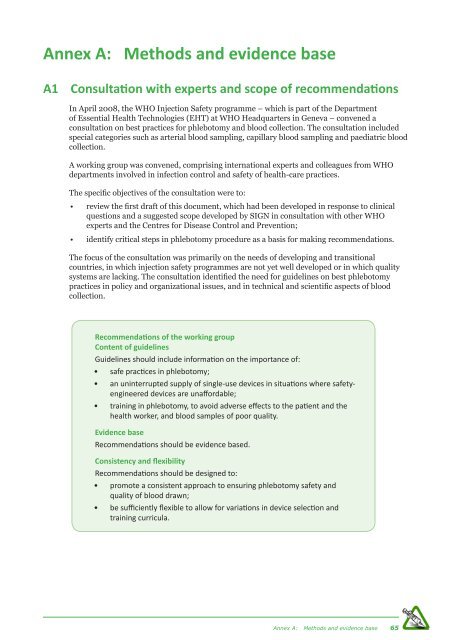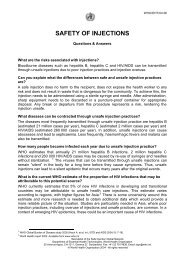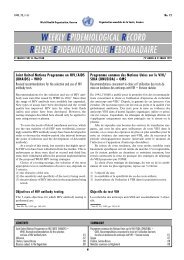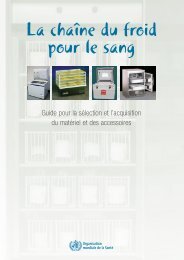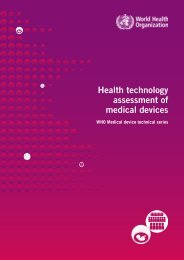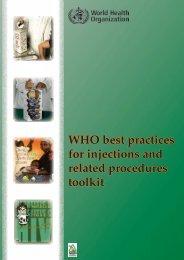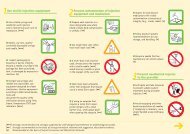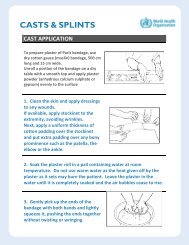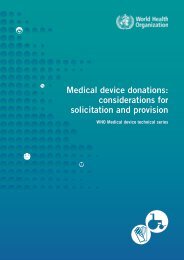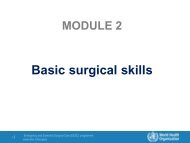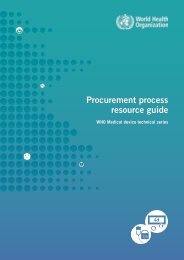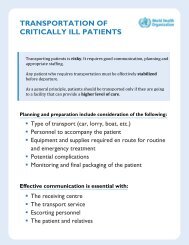WHO Guidelines on Drawing Blood: Best Practices in Phlebotomy
WHO Guidelines on Drawing Blood: Best Practices in Phlebotomy
WHO Guidelines on Drawing Blood: Best Practices in Phlebotomy
- No tags were found...
Create successful ePaper yourself
Turn your PDF publications into a flip-book with our unique Google optimized e-Paper software.
Annex A: Methods and evidence base<br />
A1 C<strong>on</strong>sultati<strong>on</strong> with experts and scope of recommendati<strong>on</strong>s<br />
In April 2008, the <str<strong>on</strong>g>WHO</str<strong>on</strong>g> Injecti<strong>on</strong> Safety programme – which is part of the Department<br />
of Essential Health Technologies (EHT) at <str<strong>on</strong>g>WHO</str<strong>on</strong>g> Headquarters <strong>in</strong> Geneva – c<strong>on</strong>vened a<br />
c<strong>on</strong>sultati<strong>on</strong> <strong>on</strong> best practices for phlebotomy and blood collecti<strong>on</strong>. The c<strong>on</strong>sultati<strong>on</strong> <strong>in</strong>cluded<br />
special categories such as arterial blood sampl<strong>in</strong>g, capillary blood sampl<strong>in</strong>g and paediatric blood<br />
collecti<strong>on</strong>.<br />
A work<strong>in</strong>g group was c<strong>on</strong>vened, compris<strong>in</strong>g <strong>in</strong>ternati<strong>on</strong>al experts and colleagues from <str<strong>on</strong>g>WHO</str<strong>on</strong>g><br />
departments <strong>in</strong>volved <strong>in</strong> <strong>in</strong>fecti<strong>on</strong> c<strong>on</strong>trol and safety of health-care practices.<br />
The specific objectives of the c<strong>on</strong>sultati<strong>on</strong> were to:<br />
• review the first draft of this document, which had been developed <strong>in</strong> resp<strong>on</strong>se to cl<strong>in</strong>ical<br />
questi<strong>on</strong>s and a suggested scope developed by SIGN <strong>in</strong> c<strong>on</strong>sultati<strong>on</strong> with other <str<strong>on</strong>g>WHO</str<strong>on</strong>g><br />
experts and the Centres for Disease C<strong>on</strong>trol and Preventi<strong>on</strong>;<br />
• identify critical steps <strong>in</strong> phlebotomy procedure as a basis for mak<strong>in</strong>g recommendati<strong>on</strong>s.<br />
The focus of the c<strong>on</strong>sultati<strong>on</strong> was primarily <strong>on</strong> the needs of develop<strong>in</strong>g and transiti<strong>on</strong>al<br />
countries, <strong>in</strong> which <strong>in</strong>jecti<strong>on</strong> safety programmes are not yet well developed or <strong>in</strong> which quality<br />
systems are lack<strong>in</strong>g. The c<strong>on</strong>sultati<strong>on</strong> identified the need for guidel<strong>in</strong>es <strong>on</strong> best phlebotomy<br />
practices <strong>in</strong> policy and organizati<strong>on</strong>al issues, and <strong>in</strong> technical and scientific aspects of blood<br />
collecti<strong>on</strong>.<br />
Recommendati<strong>on</strong>s of the work<strong>in</strong>g group<br />
C<strong>on</strong>tent of guidel<strong>in</strong>es<br />
<str<strong>on</strong>g>Guidel<strong>in</strong>es</str<strong>on</strong>g> should <strong>in</strong>clude <strong>in</strong>formati<strong>on</strong> <strong>on</strong> the importance of:<br />
• safe practices <strong>in</strong> phlebotomy;<br />
• an un<strong>in</strong>terrupted supply of s<strong>in</strong>gle-use devices <strong>in</strong> situati<strong>on</strong>s where safetyeng<strong>in</strong>eered<br />
devices are unaffordable;<br />
• tra<strong>in</strong><strong>in</strong>g <strong>in</strong> phlebotomy, to avoid adverse effects to the patient and the<br />
health worker, and blood samples of poor quality.<br />
Evidence base<br />
Recommendati<strong>on</strong>s should be evidence based.<br />
C<strong>on</strong>sistency and flexibility<br />
Recommendati<strong>on</strong>s should be designed to:<br />
• promote a c<strong>on</strong>sistent approach to ensur<strong>in</strong>g phlebotomy safety and<br />
quality of blood drawn;<br />
• be sufficiently flexible to allow for variati<strong>on</strong>s <strong>in</strong> device selecti<strong>on</strong> and<br />
tra<strong>in</strong><strong>in</strong>g curricula.<br />
Annex A: Methods and evidence base 65


